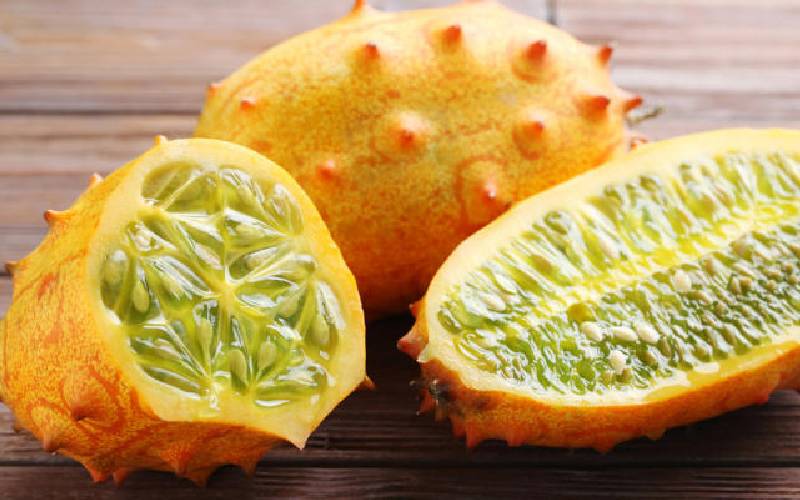
Thorn melon or the Kiwano fruit is one of the fruits that is loaded with health benefits. It is full of antioxidants, improves digestion, slows pre-mature ageing, alleviates stress and boosts metabolism. With a growing health conscious population, you can never lack a market. It can be cultivated on farms, grown naturally in the bush and adapts well in semi-arid areas and in warm to hot regions.
The fruits have orange skin when ripe and spikes on their outer surfaces but are pulpy inside. When ripe, they can be peeled and eaten or made into juice and the leaves can be used as vegetables. Victor Munyambu from Machakos County is a thorn melon farmer and shares insights on production and marketing.
Preparation and soil health
The soils should be well-drained with high organic matter. Clay or loamy soils with a pH range of 6.0 to 6.5 are best for production.
“Thorn melon is a climber and therefore requires an area near a trellis or something to promote climbing. For those doing greenhouse production, plants should be trained on posts,” says Munyambu.
Propagation and planting
Thorn melon is propagated by seeds, which can be sown directly or seedlings can be raised in the nursery and then transplanted when they have two leaves. The seeds can be extracted from a well-developed ripe healthy fruit.
Direct planting
Three to four seeds per hole are planted to a depth about 2cm and covered with a layer of soil.
Thinning
This is done five to seven days after emergence in order to remove the excess seedlings leaving one plant per hill if planted directly in the field.
Irrigation
This depends on a number of factors like the prevailing weather, soil type, and stage of crop development.
“For example, during the flowering and fruiting stage, the plants will need more water, therefore the farmer needs a steady supply of water at this time,” says Munyambu.
Weed control
Timely weeding is important to prevent diseases such as the cucumber mosaic virus and tobacco ring spot virus. Besides, weeds compete with the crop for nutrients and water.
Crop rotation
This should be practised using non-related crops like cereals, legumes and brassicas. This helps prevent build-up of pests and diseases as well as improve soil structure.
Pest and disease control
Thorn melons are susceptible to cucumber mosaic virus, tobacco ring spot virus, tomato ring spot virus, watermelon mosaic virus and fusarium wilt.
Viral diseases can be prevented by vectors such as aphids and melon flies, white flies and planting the crop away from the host plants in the cucurbit family such as cucumber, courgettes, and pumpkins.
Harvesting
Before you harvest, wait for three months for the crop to mature and start producing healthy fruits. Harvesting is done by simply picking the ripe fruits and putting them gently inside a bucket (due to their thorny nature). The average shelf life of a harvested kiwano fruit is six months. This gives the farmer adequate time to find market for the produce. An eighth-acre farm can accommodate about 80 plants and a single plant can produce 15 fruits per season.
Market
Munyambu says the fruit has great potential since the fruit has a ready market locally and internationally. He sells his produce in markets and through referrals.
 The Standard Group Plc is a multi-media organization with investments in media
platforms spanning newspaper print operations, television, radio broadcasting,
digital and online services. The Standard Group is recognized as a leading
multi-media house in Kenya with a key influence in matters of national and
international interest.
The Standard Group Plc is a multi-media organization with investments in media
platforms spanning newspaper print operations, television, radio broadcasting,
digital and online services. The Standard Group is recognized as a leading
multi-media house in Kenya with a key influence in matters of national and
international interest.
 The Standard Group Plc is a multi-media organization with investments in media
platforms spanning newspaper print operations, television, radio broadcasting,
digital and online services. The Standard Group is recognized as a leading
multi-media house in Kenya with a key influence in matters of national and
international interest.
The Standard Group Plc is a multi-media organization with investments in media
platforms spanning newspaper print operations, television, radio broadcasting,
digital and online services. The Standard Group is recognized as a leading
multi-media house in Kenya with a key influence in matters of national and
international interest.










